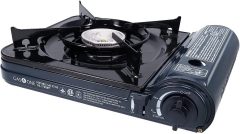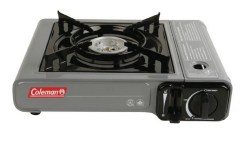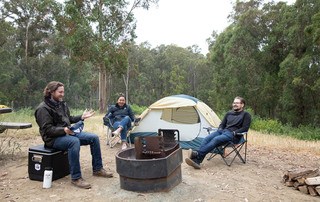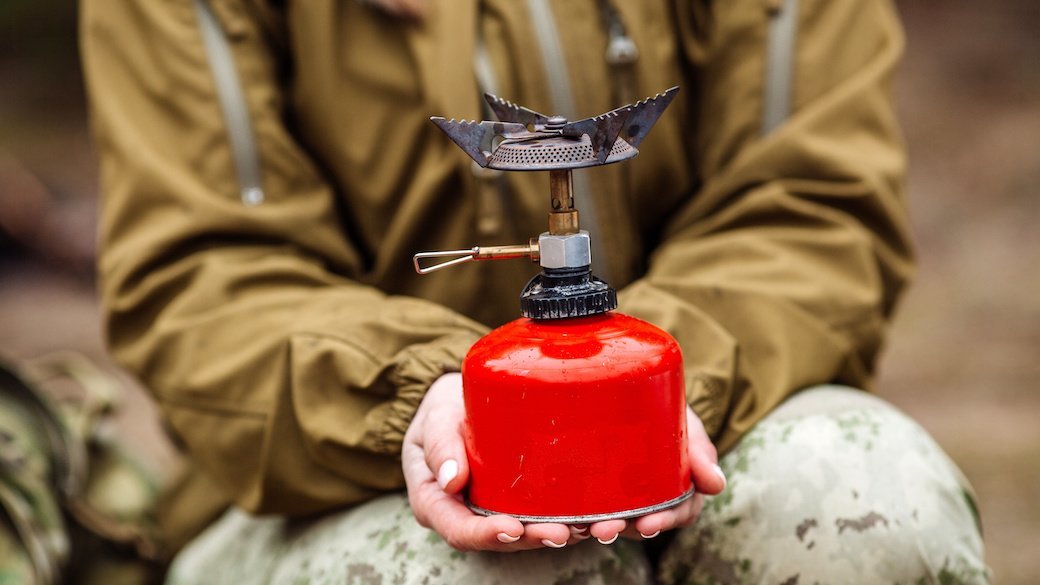

A powerful portable butane stove that can work both outdoors or indoors.
Outputs up to 15,000 BTU. Piezoelectric ignition. Simple ignition and adjustment knob controls the flame. Inline regulator with pressure-sensing auto-shutoff for enhanced safety. Wind baffle shields the flame for safety and performance. Comes with hardshell carrying case.
Igniter performance is reportedly inconsistent sometimes.
Best Bang for the Buck
This outdoor butane stove is light, affordable, and outputs a good amount of heat.
Delivers up to 10,000 BTUs of heat. Piezo ignition for quick operation and adjustability also comes with safety lock. Auto-shutoff functionality for additional safety. Grates are long and textured for stability of cookware. Weighs only 4.44 pounds, easily portable. Low price.
Not intended for indoor use.

A mid-price stove that puts out 10,000 BTUs and comes with welcome safety features.
Has an adjustable heat range, a piezo ignition system, and an inline regulator with pressure-sensing shutoff for safety. Lightweight at 1.99 pounds. Certified for indoor use. Comes with a carrying case. Has a total heat output of 10,000 BTUs which is perfect for cooking a wide variety of foods.
Some users felt that it didn't last as long as other options.

If you need a simple single-burner stove for camping, this inexpensive option is worth considering.
Single-burner stove that's lightweight and highly portable. The burner can accommodate cookware up to 10 inches in size. Features reliable wind baffles and adjustable temperature control. The rust-resistant build includes a porcelain-coated cooking grate that's easy to clean.
At 7,650 BTUs, it's a bit underpowered. For outdoor use only.

While it is expensive, it's among the rare models that can deliver up to 15,000 BTUs.
Its carefully engineered design sports an advanced burner protected by vented, wind-blocking walls. Very few competing models can keep up with its 15,000-BTU peak output. Its durable metallic finish is also easy to clean. Works as both and indoor and outdoor stove.
Extremely high cost for a single-burner model.

BestReviews spends thousands of hours researching, analyzing, and testing products to recommend the best picks for most consumers. We only make money if you purchase a product through our links, and all opinions about the products are our own. About BestReviews
BestReviews spends thousands of hours researching, analyzing, and testing products to recommend the best picks for most consumers. We only make money if you purchase a product through our links, and all opinions about the products are our own. About BestReviews
BestReviews spends thousands of hours researching, analyzing, and testing products to recommend the best picks for most consumers. We buy all products with our own funds, and we never accept free products from manufacturers.About BestReviews
HOW WE TESTEDWe recommend these products based on an intensive research process that's designed to cut through the noise and find the top products in this space. Guided by experts, we spend hours looking into the factors that matter, to bring you these selections.
Click here for testing insights Models

Updated February 2024
A simple design and ease of use make butane stoves a popular choice with campers and backpackers alike. These stoves can quickly boil water or heat a meal, and butane canisters are generally smaller than propane canisters, which is a consideration if you’re backpacking.
Butane camping stoves have one or two burners and are designed for tabletop use. While using one of these is similar to cooking on a range, camping stoves are too bulky to fit in a backpack. Butane backpacking stoves consist of a single burner that can be set up on any level surface. While less efficient than tabletop models, they’re lightweight for carrying and compact for easy storage. Butane stoves vary in burn time, heat output, and ignition method, and many are quite inexpensive.
Choosing the right butane stove can make a big difference in your camping or backpacking experience.


Butane stoves aren’t just for camping. One also comes in handy during a power outage or emergency, but be sure to use it in a well-ventilated area.
Butane stoves use canisters of compressed flammable gas (butane) to generate heat in the form of a flame. These canisters typically hold eight ounces of fuel, but there are larger canisters for use with two-burner stoves. Butane is less common than propane, which can make it harder to find. In addition, butane does not perform well in cold weather.
There are some significant differences between stoves you use for backpacking and stoves you use for camping.
The heat output of a butane stove (and other types of stoves) is measured in British thermal units. The higher the BTU rating, the faster a butane stove should heat, in theory. However, this also depends on the design of the stove and isn’t always precise. In general, a backpacking stove offers around 8,000 BTU, while a camping stove offers from 10,000 to 20,000 BTU.
The longer the burn time the better, right? Of course, you want a stove that provides heat for your whole trip, but you also need to consider the size and weight of the stove. If you’re camping out of the back of your car, you might be able to opt for a bulkier stove with excellent burn time. If you’re backpacking, however, you’ll likely want a smaller stove with a shorter burn time. Finding a balance between design, burn time, and BTU rating is the key to choosing the right butane stove for your needs.
Like other camping stoves, butane stoves vary in ignition method, additional fuel sources, and other features.
Most butane stoves use an automatic ignition method known as piezo ignition, which means an electric spark ignites the fuel. There may be an ignition button, or you may simply have to turn the flame adjustment knob to the ignition setting. Some less-expensive butane stoves may have manual ignition, requiring you to use a match or lighter to ignite the gas.
Some butane camping stoves have a windscreen, which helps to protect the flame and keep your food cooking at a steady temperature. Due to the risk of explosion, single-burner backpacking stoves do not usually have a windscreen.
Some butane stoves also accept other types of fuel, such as propane.
While you want to consider the size and weight of a butane stove, you should also consider how easily it can be packed in your gear and carried. Many backpacking stoves simply have legs that fold up, while tabletop stoves may fold down and be carried like a briefcase.
Butane stoves that cost $10 to $20 are almost exclusively single-burner backpacking stoves. The price doesn’t mean they’re cheaply made. These stoves are good at what they do — providing a lightweight and compact heat source for boiling water or cooking small meals.
In the $20 to $50 category are backpacking and camping stoves that generally have one burner. The burn times and BTU ratings vary greatly in this price range.
High-end butane stoves that cost $50 to $100 are usually camping stoves with one or two burners. These typically have high BTU ratings that allow you to quickly cook larger meals, and some may accept alternate fuel sources.


Butane stoves range in size from collapsible models that can fit in a pocket to large, two-burner ranges designed to sit on a table.
A. Any stove can be dangerous. With butane stoves, the biggest risk is the fuel canister overheating and exploding. This may sound alarming, and it is. To avoid this risk, look for a model with an automatic shutoff valve that can sense if the canister is overheating.
A. Since butane canisters contain compressed gas, it can be difficult to tell how much gas is left by feeling the weight. You really can’t judge the amount of fuel with any accuracy. As a result, your best bet is to bring extra canisters on the trip.
A. Butane canisters should be stored away from sunlight and heat in a well-ventilated area.